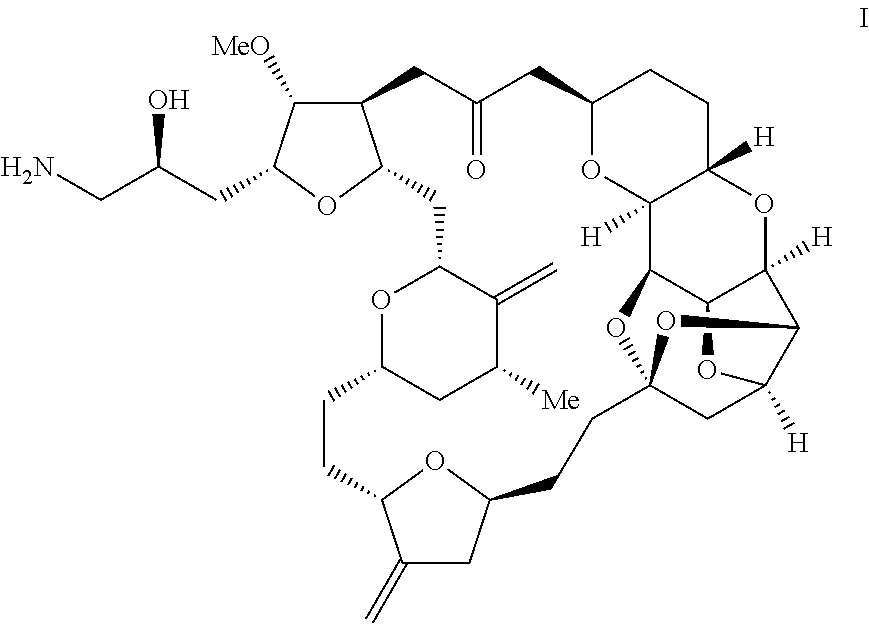Method for preparing eribulin intermediate
a technology of eribulin and intermediate, which is applied in the field of preparing an eribulin intermediate, can solve the problems of difficult scaling up of the method for industrial production, difficult to achieve stereoselective control of each chiral center during the and complicated preparation process of total synthesis route and process of eribulin
- Summary
- Abstract
- Description
- Claims
- Application Information
AI Technical Summary
Benefits of technology
Problems solved by technology
Method used
Image
Examples
example 1
[0042]Preparation of the Compound of Formula VIIa
[0043]The compound of formula IXa (13.1 g, prepared according to Tetrahedron Lett. 2001, 42, 9233) was dissolved in tetrahydrofuran (240 mL). The reaction mixture was cooled to −10° C., and then a solution of LDA in tetrahydrofuran (46 mL, 1.0 M) was added dropwise. The reaction mixture was stirred at −10° C. for 2 hours, and then a compound of formula VIIIa (6.5 g, prepared according to Angew. Chem. Intl. Ed. 2009, 48, 5121) was added. After the reaction mixture was stirred at −10° C. for another 2 hours, it was quenched with a saturated aqueous solution of ammonium chloride (56 mL) and then extracted with 200 mL ethyl acetate. The organic layer was separated, dried over anhydrous sodium sulfate, concentrated, and then purified by column chromatography to obtain the compound of formula VIIa (14.2 g).
[0044]1H NMR (CDCl3, 400 MHz) δ=7.68-7.64 (m, 4H), 7.46-7.32 (m, 11H), 4.51 (s, 2H), 4.10-4.07 (m, 1H), 3.97-3.86 (m, 3H), 3.73-3.67 (m,...
example 2
[0045]Preparation of the Compound of Formula VIa
[0046]The compound of formula VIIa (12.2 g) was dissolved in tetrahydrofuran (330 mL). The reaction mixture was cooled to −30° C., and then a solution of DIBAL-H in hexane (66 mL, 1.0 M solution) was added dropwise. After the reaction mixture was stirred at −30° C. for 5 hours, it was quenched with 8 mL methanol and 160 mL of a saturated aqueous solution of potassium sodium tartrate, and then extracted with 300 mL ethyl acetate. The organic layer was separated, dried over anhydrous sodium sulfate, concentrated, and then purified by column chromatography to obtain the compound of formula VIa (9.6 g).
[0047]1H NMR (CDCl3, 400 MHz) δ=7.68-7.64 (m, 4H), 7.46-7.32 (m, 11H), 4.51 (s, 2H), 4.10-4.07 (m, 1H), 3.97-3.86 (m, 3H), 3.73-3.67 (m, 2H), 3.55-3.49 (m, 2H), 1.05 (s, 9H).
example 3
[0048]Preparation of the Compound of Formula Va
[0049]The compound of formula VIa (8.0 g) was dissolved in tetrahydrofuran (300 mL). The reaction mixture was cooled to 0° C., and then silver(II) oxide (3.2 g) and silver trifluoromethanesulfonate (3.5 g) were added. After the reaction mixture was stirred at 20° C. for 18 hours, it was quenched with a saturated aqueous solution of sodium bicarbonate, and then extracted with 200 mL ethyl acetate. The organic layer was separated, dried over anhydrous sodium sulfate, concentrated, and then purified by column chromatography to obtain the compound of formula Va (6.9 g).
[0050]1H NMR (CDCl3, 400 MHz) δ=7.68-7.64 (m, 4H), 7.42-7.32 (m, 11H), 4.51 (s, 1.6H), 4.50 (s, 0.4H), 4.25-4.15 (m, 1.6H), 4.05-3.92 (m, 0.8H), 3.79-3.74 (td, J=2.9, 6.9 Hz, 1H), 3.70-3.65(m, 2H), 3.56-3.47 (m, 2H), 2.09-1.99 (m, 2H), 1.04 (s, 9H).
PUM
| Property | Measurement | Unit |
|---|---|---|
| reaction mixture | aaaaa | aaaaa |
Abstract
Description
Claims
Application Information
 Login to View More
Login to View More - R&D
- Intellectual Property
- Life Sciences
- Materials
- Tech Scout
- Unparalleled Data Quality
- Higher Quality Content
- 60% Fewer Hallucinations
Browse by: Latest US Patents, China's latest patents, Technical Efficacy Thesaurus, Application Domain, Technology Topic, Popular Technical Reports.
© 2025 PatSnap. All rights reserved.Legal|Privacy policy|Modern Slavery Act Transparency Statement|Sitemap|About US| Contact US: help@patsnap.com



